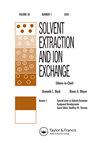新癸酸与1-(2-Neononylamidoethyl)-2- neononyl -2-咪唑啉混合溶剂协同萃取铒(III
IF 2.1
4区 化学
Q3 CHEMISTRY, MULTIDISCIPLINARY
引用次数: 0
摘要
研究了新癸酸(HA)与1-(2-新炔酰胺乙基)-2-新炔-2-咪唑啉(L)在甲苯中以15% (v/v)的正癸醇为溶剂从硝酸溶液中萃取重系镧的方法。在平衡pH为6.0 ~ 6.5的范围内,发现了铒(III)的协同萃取。考察了平衡时间、温度、稀释剂性质、水相酸度以及一种萃取剂在另一种萃取剂固定浓度下的变化等因素的影响。温度在0 ~ 45℃范围内对提取过程无影响。考察了混合萃取剂萃取铒前后的FT-IR光谱,并测定了混合萃取剂对Er(III)的负载能力。实验数据表明,铒离子不与L直接配位,硝态氮离子不参与铒(III)的萃取。在平衡pH 5.0 ~ 6.0范围内,通过斜率分析法确定提取物为[Er(OH)A2·L]。随着pH的增加,[Er(OH)2A·L]成为主要的被萃取物。讨论了萃取机理。计算了Nd/Pr、Y/Pr、Dy/Y、Ho/Y和Er/Y分离因子,并证明了Er - Y对分离的可能性。本文章由计算机程序翻译,如有差异,请以英文原文为准。
Synergistic Solvent Extraction of Erbium(III) using a Mixture of Neodecanoic Acid with 1-(2-Neononylamidoethyl)-2-Neononyl-2-Imidazoline
ABSTRACT The solvent extraction of erbium(III), representing heavy lanthanides, from nitrate solutions has been studied using a novel mixture of neodecanoic acid (HA) with 1-(2-neononylamidoethyl)-2-neononyl-2-imidazoline (L) in toluene with 15 % (v/v) of n-decanol. The synergistic extraction of erbium(III) has been found in the equilibrium pH range from 6.0 to 6.5. The effects of the equilibration time, the temperature, the nature of diluent, the aqueous phase acidity, and variation of one extractant at a fixed concentration of the other extractant have been investigated. The temperature had no effect on the extraction process in the range of 0–45°C. FT-IR spectra of the mixed extractant before and after extraction of erbium were examined, and the loading capacity of the mixed extractant for Er(III) was determined. The experimental data indicated that the erbium ion is not directly coordinated by L, and the nitrate ions are not involved in the extraction of erbium(III). In the equilibrium pH range between 5.0 and 6.0, the extracted species were determined to be [Er(OH)A2·L] by the slope analysis method. The increase in the pH leads to the dominance of [Er(OH)2A·L] as the main extracted species. The extraction mechanism is discussed. The Nd/Pr, Y/Pr, Dy/Y, Ho/Y, and Er/Y separation factors were calculated, and the possibility of the separation of the Er–Y pair was demonstrated.
求助全文
通过发布文献求助,成功后即可免费获取论文全文。
去求助
来源期刊
CiteScore
4.40
自引率
5.00%
发文量
15
审稿时长
8.4 months
期刊介绍:
Solvent Extraction and Ion Exchange is an international journal that publishes original research papers, reviews, and notes that address all aspects of solvent extraction, ion exchange, and closely related methods involving, for example, liquid membranes, extraction chromatography, supercritical fluids, ionic liquids, microfluidics, and adsorption. We welcome submissions that look at: The underlying principles in solvent extraction and ion exchange; Solvent extraction and ion exchange process development; New materials or reagents, their syntheses and properties; Computational methods of molecular design and simulation; Advances in equipment, fluid dynamics, and engineering; Interfacial phenomena, kinetics, and coalescence; Spectroscopic and diffraction analysis of structure and dynamics; Host-guest chemistry, ion receptors, and molecular recognition.

 求助内容:
求助内容: 应助结果提醒方式:
应助结果提醒方式:


